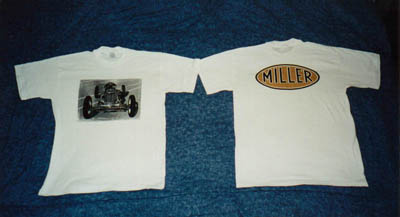The Harry A. Miller Club Vintage Indy Car Exhibition, 2000
The Harry A. Miller Club Vintage Indy Car Exhibition was held July 8-9th at the Wisconsin State Fairgrounds in West Allis, Wisc. The Milwaukee Mile track is purported to be the oldest continuously operating race track in North America, operating as early as 1907.
It rained hard on Saturday morning but the track was dry by noon and there was plenty of track action. Sunday saw more cars on the track and a special feature consisting of a film shoot of all the Miller race cars in attendance on the track at the same time. Each year continues to bring out different cars, many of which are seen at no other event. Virtually all the cars in attendance made it onto the track and thrilled the onlookers with their sounds.
The Club has done a great job of preserving
a wonderfully cordial and open atmosphere for all attendees. At what
other event can you stand in pit row and watch and listen to the best historical
race cars from around the world and then go and chat with the owners, drivers,
and restorers at leisure?
Cars on the attendance list included:
1933 Hudson Martz
Spl # 29
Bauman
1926 Amilcar
Butler
1948 Talbot Lago
T26C GP
Butler
1931 Miller V16
Davis
1953 Kurtis-Chrysler
# 25
Davis
1931 Brandfon Duesenberg
# 66 Davis
1935 Miller-Ford
# 23
Davis
1951 Kurtis 4000/Offy
# 5
Dittman
1913 Mercer # 18
Eby
1957 Kurtis G2-6
Offy
Ford
1911 Marmon # 6
Gill
1935 Miller-Ford
# 42
Evans
c-1950 dirt Offy
Hahn
1964 Fed Engr #
15 (Meskowski) Johnson
1912 Mercer Model
35
Lederer
1964 Kuzma Offy
Lyons
1937 Miller # 1
Malloy
1962 Watson Offy
# 76
Malloy
1948 Clancy 6-wheeler
# 19
Watson
1923 Mercedes/Miller
McConnell
1963 Watson/Offy
#1
McConnell
1934 Sparks-Weirick
Miller # 33
Mecum
1951 KK3000/Offy
# 77
Mueller
1924 Miller 122
rear drive
Nearburg
1952 Turner champ
car # 73 (McNamara)
Rasansky
1963 Elder/Offy
# 28
Revennaugh
1959 Watson/Offy
#5
Ryan
1959 Cornis/Offy
# 51
Scheuerman
1961 Chenoweth/Chevy
# 82
Schleppi
1952 KK4000/Offy
# 1
Schroeder (Hanks car)
1933 Ford # 49
Schwab
1947 Indy car #
2 w/ Miller 220
Truchan
1964 Watson/Offy
# 94
Truchan
1925 Miller FD
# 25
Uihlein
1931 Bowes/Miller
# 23
Uihlein
1932 Alfa P3
Uihlein
1933 Alfa Monza
Uihlein
1938 Thorne/Sparks
"Big Six."
Uihlein
The Miller 122 front-drive in the photos is one of two 122 front-drives built, is supercharged, and was completed in 1925. Harry Miller built it for himself and it was sold shortly thereafter to the Packard Motor Company for their research into front-wheel drive. The other 122 front-drive, Jimmy Murphy's car, is at the Indianapolis Speedway Museum and is featured in AQ Vol. 21 No. 4.
The Bowes Seal Fast is the 1931 Indy 500 winner. The engine is a Miller 122 bored out to 151 cu in and the body was built by Myron Stevens.
The Miller V16 is the 1931 and 1932 Indy car. Miller originally built the 303 cu in motor for his Cord L-29. The race car's amazing restoration is featured in AQ Vol. 40 No. 1.
The Miller-Ford is one of the ten cars that Ford had built for them by Miller, via Tucker, for the 1935 Indy 500.
The Miller-Gulf 255 cu in engine is a design originally penned for Ira Vail in 1937 for two rear-drive combination dirt-track and champ cars. Gulf Oil bought out Ira Vail shortly after construction was started and built the Miller-Gulf 6 cylinder racing cars. However, work continued on the 4 cylinder cars and they tried but did not qualify for the 1938 Indy. Gulf later sold the cars to Tucker who used the engines in his failed attempt to produce a military aircraft.
If you look carefully at the different photos of the Millers on the track, you can see the dramatic design differences in the cars. The pictures were taken from the mechanic's seat in the Miller-Ford.
Photos
(click on any photo to enlarge to
full-size)
Sounds
These audio tracks were recorded on a MiniDisc recorder. They are in stereo and are saved at the widest possible frequency response (20Hz - 16kHz) available within RealPlayer (hence the large file size). RealPlayer (rm) was chosen over Windows advanced streaming format (asf) because the accuracy of the sound is noticeably better. The track sounds should all run clearly from right to left: sometimes streaming audio mixes this up during playback and you hear left to right or just mono. Replaying the sound again after the first playback usually gets it to play correctly. To really hear how the cars sounded, hook up a pair of full-range, high quality home speakers or high quality headphones rather than just using typical computer speakers.
The recording location was
directly across from the grandstands, facing the track. The cars accelerate
out of the turn off to the right, come down the grandstand straight from
right to left, and then decelerate for the next turn. You can occasionally
hear voices and other cars in the pit row that was right behind the recording
location. The recordings for the cockpit audio tracks were taken while
riding in the mechanic's seat.
Miller 122 front-drive (508k - 50 sec) - two passes, a great engineMiller V16 cockpit, on the track (305k - 30 sec) - hear the whole powertrain and engine clearly
Miller-Ford (104k - 10 sec) - smooth
Sparks Big Six (146k - 14 sec) - a completely different sound
A Miller T-shirt was
designed and sold at the exhibition.

If you're interested in one, please write to milleroffy@aol.com.Front Back